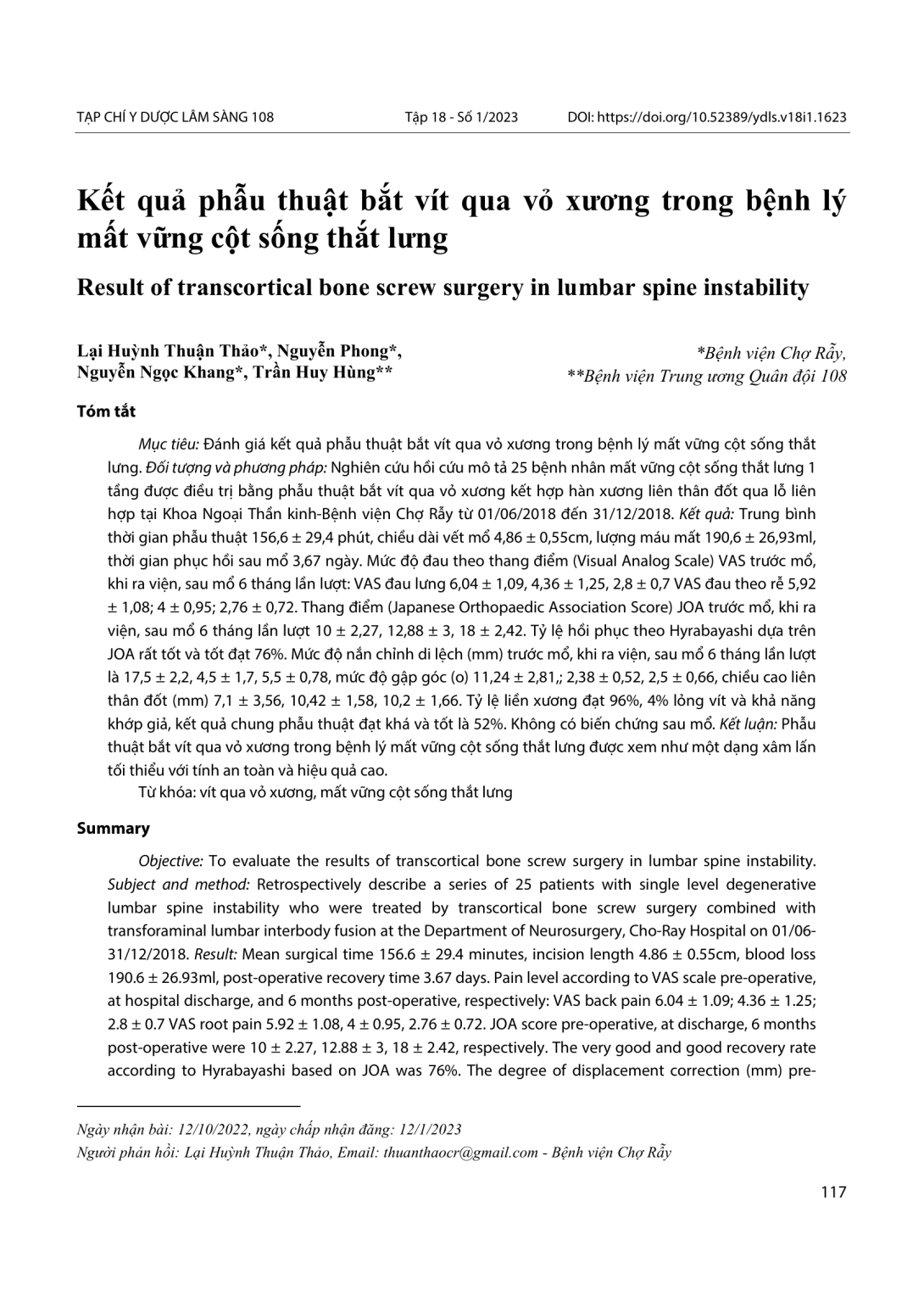
Đánh giá kết quả phẫu thuật bắt vít qua vỏ xương trong bệnh lý mất vững cột sống thắt lưng. Đối tượng và phương pháp: Nghiên cứu hồi cứu mô tả 25 bệnh nhân mất vững cột sống thắt lưng 1 tầng được điều trị bằng phẫu thuật bắt vít qua vỏ xương kết hợp hàn xương liên thân đốt qua lỗ liên hợp tại Khoa Ngoại Thần kinh-Bệnh viện Chợ Rẫy từ 01/06/2018 đến 31/12/2018. Kết quả: Trung bình thời gian phẫu thuật 156,6 ± 29,4 phút, chiều dài vết mổ 4,86 ± 0,55cm, lượng máu mất 190,6 ± 26,93ml, thời gian phục hồi sau mổ 3,67 ngày. Mức độ đau theo thang điểm (Visual Analog Scale) VAS trước mổ, khi ra viện, sau mổ 6 tháng lần lượt: VAS đau lưng 6,04 ± 1,09, 4,36 ± 1,25, 2,8 ± 0,7 VAS đau theo rễ 5,92 ± 1,08; 4 ± 0,95; 2,76 ± 0,72. Thang điểm (Japanese Orthopaedic Association Score) JOA trước mổ, khi ra viện, sau mổ 6 tháng lần lượt 10 ± 2,27, 12,88 ± 3, 18 ± 2,42. Tỷ lệ hồi phục theo Hyrabayashi dựa trên JOA rất tốt và tốt đạt 76%. Mức độ nắn chỉnh di lệch (mm) trước mổ, khi ra viện, sau mổ 6 tháng lần lượt là 17,5 ± 2,2, 4,5 ± 1,7, 5,5 ± 0,78, mức độ gập góc (o) 11,24 ± 2,81,; 2,38 ± 0,52, 2,5 ± 0,66, chiều cao liên thân đốt (mm) 7,1 ± 3,56, 10,42 ± 1,58, 10,2 ± 1,66. Tỷ lệ liền xương đạt 96%, 4% lỏng vít và khả năng khớp giả, kết quả chung phẫu thuật đạt khá và tốt là 52%. Không có biến chứng sau mổ. Kết luận: Phẫu thuật bắt vít qua vỏ xương trong bệnh lý mất vững cột sống thắt lưng được xem như một dạng xâm lấn tối thiểu với tính an toàn và hiệu quả cao.
To evaluate the results of transcortical bone screw surgery in lumbar spine instability. Subject and method: Retrospectively describe a series of 25 patients with single level degenerative lumbar spine instability who were treated by transcortical bone screw surgery combined with transforaminal lumbar interbody fusion at the Department of Neurosurgery, Cho-Ray Hospital on 01/06- 31/12/2018. Result: Mean surgical time 156.6 ± 29.4 minutes, incision length 4.86 ± 0.55cm, blood loss 190.6 ± 26.93ml, post-operative recovery time 3.67 days. Pain level according to VAS scale pre-operative, at hospital discharge, and 6 months post-operative, respectively: VAS back pain 6.04 ± 1.09; 4.36 ± 1.25; 2.8 ± 0.7 VAS root pain 5.92 ± 1.08, 4 ± 0.95, 2.76 ± 0.72. JOA score pre-operative, at discharge, 6 months post-operative were 10 ± 2.27, 12.88 ± 3, 18 ± 2.42, respectively. The very good and good recovery rate according to Hyrabayashi based on JOA was 76%. The degree of displacement correction (mm) pre-operative, at hospital discharge, and 6 months post-operative were 17.5 ± 2.2, 4.5 ± 1.7, 5.5 ± 0.78, respectively; degree of folding angle (0) 11.24 ± 2.81, 2.38 ± 0.52, 2.5 ± 0.66, interbody height (mm) 7.1 ± 3.56, 10.42 ± 1.58, 10.2 ± 1.66. The rate of bone healing reached 96%, 4% screw loose and the possibility of pseudarthrosis; the good overall surgical outcome was 52%. There were no postoperative complications. Conclusion: Transcortical bone screw surgery in degenerative lumbar spine instability is considered as a minimally invasive surgery with safety and effectiveness.
- Đăng nhập để gửi ý kiến
